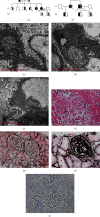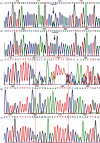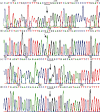Review and Analysis of Two Gitelman Syndrome Pedigrees Complicated with Proteinuria or Hashimoto's Thyroiditis Caused by Compound Heterozygous SLC12A3 Mutations
- PMID: 34046503
- PMCID: PMC8128541
- DOI: 10.1155/2021/9973161
Review and Analysis of Two Gitelman Syndrome Pedigrees Complicated with Proteinuria or Hashimoto's Thyroiditis Caused by Compound Heterozygous SLC12A3 Mutations
Abstract
Gitelman syndrome (GS) is an autosomal recessive inherited salt-losing renal tubular disease, which is caused by a pathogenic mutation of SLC12A3 encoding thiazide-sensitive Na-Cl cotransporter, which leads to disturbance of sodium and chlorine reabsorption in renal distal convoluted tubules, resulting in phenotypes such as hypovolemia, renin angiotensin aldosterone system (RAAS) activation, hypokalemia, and metabolic alkalosis. In this study, two GS families with proteinuria or Hashimoto's thyroiditis were analyzed for genetic-phenotypic association. Sanger sequencing revealed that two probands carried SLC12A3 compound heterozygous mutations, and proband A carried two pathogenic mutations: missense mutation Arg83Gln, splicing mutation, or frameshift mutation NC_000016.10:g.56872655_56872667 (gcggacatttttg>accgaaaatttt) in exon 8. Proband B carries two missense mutations: novel Asp839Val and Arg904Gln. Both probands manifested hypokalemia, hypomagnesemia, hypocalcinuria, metabolic alkalosis, and RAAS activation; in addition, the proband A exhibited decreased urinary chloride, phosphorus, and increased magnesium ions excretion, complicated with Hashimoto's Thyroiditis, while the proband B exhibited enhanced urine sodium excretion and proteinuria. The older sister of proband B with GS also had Hashimoto's thyroiditis. Electron microscopy revealed swelling and vacuolar degeneration of glomerular epithelial cells, diffuse proliferation of mesangial cells and matrix, accompanied by a small amount of low-density electron-dense deposition, and segmental fusion of epithelial cell foot processes in proband B. Light microscopy showed mild mesangial hyperplasia in the focal segment of the glomerulus, hyperplasia, and hypertrophy of juxtaglomerular apparatus cells, mild renal tubulointerstitial lesions, and one glomerular sclerosis. So, long-term hypokalemia of GS can cause kidney damage and may also be susceptible to thyroid disease.
Copyright © 2021 Jian-hui Zhang et al.
Conflict of interest statement
The authors do not have any conflicts of interest to declare.
Figures



Similar articles
-
Gitelman syndrome with Graves' disease leading to rhabdomyolysis: a case report and literature review.BMC Nephrol. 2023 May 2;24(1):123. doi: 10.1186/s12882-023-03180-8. BMC Nephrol. 2023. PMID: 37131142 Free PMC article. Review.
-
Identification of compound mutations of SLC12A3 gene in a Chinese pedigree with Gitelman syndrome exhibiting Bartter syndrome-liked phenotypes.BMC Nephrol. 2020 Aug 5;21(1):328. doi: 10.1186/s12882-020-01996-2. BMC Nephrol. 2020. PMID: 32758178 Free PMC article.
-
A pedigree analysis of two homozygous mutant Gitelman syndrome cases.Endocr J. 2015;62(1):29-36. doi: 10.1507/endocrj.EJ14-0289. Epub 2014 Oct 2. Endocr J. 2015. PMID: 25273610
-
A NOVEL COMPOUND HETEROZYGOUS VARIANT OF SLC12A3 GENE IN A PEDIGREE WITH GITELMAN SYNDROME CO-EXISTENT WITH THYROID DYSFUNCTION.Endocr Pract. 2018 Oct 2;24(10):889-893. doi: 10.4158/EP-2018-0218. Epub 2018 Aug 7. Endocr Pract. 2018. PMID: 30084681
-
A novel compound heterozygous mutation of SLC12A3 gene in a pedigree with Gitelman syndrome and literature review.Genes Genomics. 2020 Sep;42(9):1035-1040. doi: 10.1007/s13258-020-00960-6. Epub 2020 Jul 25. Genes Genomics. 2020. PMID: 32712837 Review.
Cited by
-
Clinicopathological Features of Gitelman Syndrome with Proteinuria and Renal Dysfunction.Nephron. 2023;147(9):531-540. doi: 10.1159/000529775. Epub 2023 Feb 20. Nephron. 2023. PMID: 36806220 Free PMC article.
-
A novel homozygous SLC12A3 mutation causing Gitelman syndrome with co-existent autoimmune thyroiditis: a case report and review of the literature.CEN Case Rep. 2024 Oct;13(5):330-338. doi: 10.1007/s13730-023-00845-z. Epub 2024 Feb 3. CEN Case Rep. 2024. PMID: 38308744 Free PMC article. Review.
-
Gitelman syndrome with Graves' disease leading to rhabdomyolysis: a case report and literature review.BMC Nephrol. 2023 May 2;24(1):123. doi: 10.1186/s12882-023-03180-8. BMC Nephrol. 2023. PMID: 37131142 Free PMC article. Review.
-
The role of SLC12A3 gene variant c.1964G > A in co-existing Gitelman syndrome and unilateral limb paralysis: a case report and literature review.BMC Nephrol. 2025 Mar 26;26(1):153. doi: 10.1186/s12882-025-04075-6. BMC Nephrol. 2025. PMID: 40140779 Free PMC article. Review.
-
Novel compound heterozygous mutation of SLC12A3 in Gitelman syndrome co-existent with hyperthyroidism: A case report and literature review.World J Clin Cases. 2022 Jul 26;10(21):7483-7494. doi: 10.12998/wjcc.v10.i21.7483. World J Clin Cases. 2022. PMID: 36158002 Free PMC article.
References
-
- Gitelman H. J., Graham J. B., Welt L. G. A new familial disorder characterized by hypokalemia and hypomagnesemia. Transactions of the Association of American Physicians. 1966;79:221–235. - PubMed
-
- Pollak M. R., Delaney V. B., Graham R. M., Hebert S. C. Gitelman's syndrome (Bartter's variant) maps to the thiazide-sensitive cotransporter gene locus on chromosome 16q13 in a large kindred. Journal of the American Society of Nephrology. 1996;7(10):2244–2248. - PubMed
MeSH terms
Substances
LinkOut - more resources
Full Text Sources
Other Literature Sources

